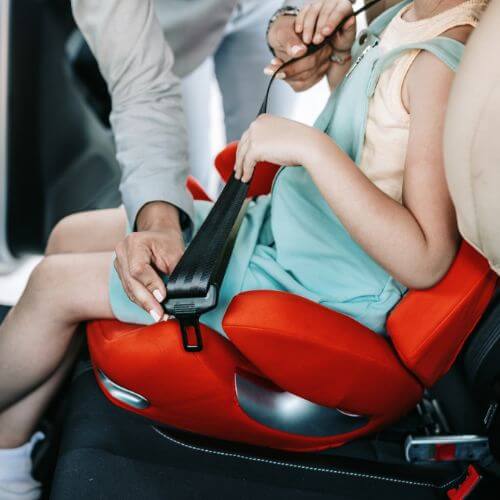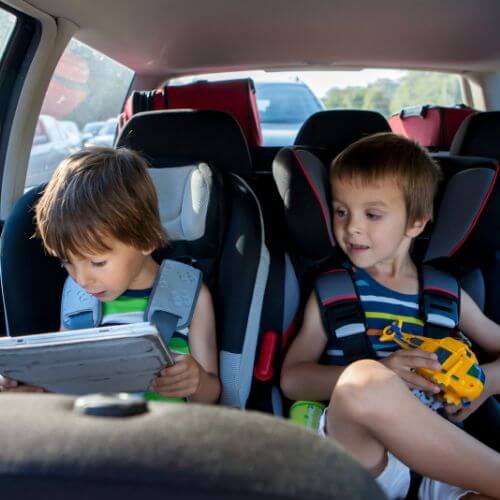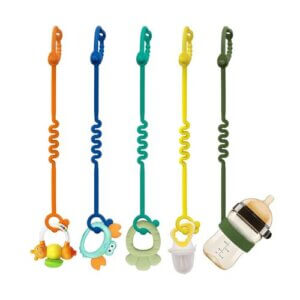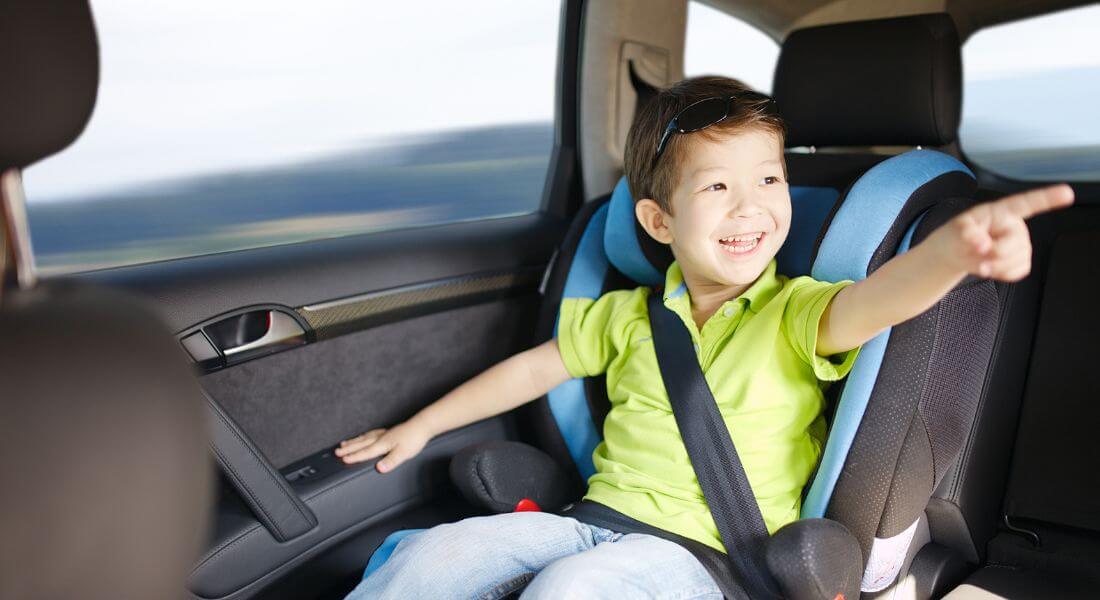Hopebridge Regional Trainer and OT Address Sensory Challenges and Safety Concerns on the Road for Children with Autism
If your last Spotify Wrapped was topped by Cocomelon, Kidz Bop or Encanto, this post may be for you. If your toddler turns into a gymnast mastering a backbend each time you try to put them in the car seat, this post is for you. And if you dread getting into the car each day, knowing you’ll hear cries of “I’m stuck!” for the next 10 minutes, this post is definitely for you.
Ensuring the safety and comfort of our children during car rides is paramount, but let’s face it—it’s often easier said than done. Then, for families with children who have autism spectrum disorder (ASD) or other developmental disorders, navigating car safety can present a whole set of new challenges. Sensory sensitivities, aversions to car seats and anxiety surrounding transitions can all complicate the journey.
Whether drives in the car cause stress or joy for your child, it is always good to review safety reminders for the road. To address common challenges, we connected with Hopebridge Florida Regional Trainer Katie Morris and Outpatient Fieldwork and Hopebridge Professional Development Advisor Abigail Hamilton, who is also an occupational therapist. They are accustomed to working with families on these types of goals as part of our applied behavior analysis (ABA) and occupational therapy programs, and together, they provided actionable advice for families as it relates to staying safe in the car.
Car Safety Challenges for Kids with Autism
“Even as an adult, I don’t like to feel restricted. Now factor in a five-point harness for some of our smaller children, and it is no wonder some kids have trouble with it,” said Katie, who has a background as a Registered Behavior Technician (RBT) and in safety training, while also serving as mom to two kids, including a 2-year-old. “Children with autism often experience additional challenges that can make car rides even more overwhelming. It’s important to put safety first, but we should still work to make them more comfortable.”
Some of the common challenges children and families may experience in the car include:
- Difficulties transitioning between locations or activities
- Discomfort or refusal to sit in the car seat or wear a seatbelt
- Unbuckling the seatbelt while the car is moving
- Throwing items inside or outside of the vehicle
- Opening the window or door while the car is moving
- Sensory sensitivities
Car rides can be especially distressing for children with sensory processing disorder (SPD) or specific sensory sensitivities. For instance:
- A child with visual sensitivities may become overwhelmed as items pass by the window or bright lights shine through a dark night.
- A child with auditory sensitivities may struggle on a busy highway or when someone honks a horn nearby.
- A child with olfactory sensitivities (sense of smell) may struggle when they drive past roadkill or near a smelly factory.
- A child with tactile sensitivities may struggle with the itch of the seatbelt against their neck or chest.
- A child with vestibular system sensitives (sense of movement in space) may get car sick from the disconnect of “my eyes are telling me we are moving, but it feels like I’m sitting still.”
Tips for Car Safety and Comfort for Kids
These challenges can make car rides distressing for children and caregivers alike, but there are steps adults can take to make the drive a safer, easier and more comfortable ride for everyone involved. Both Katie and Abigail emphasize preparation, whether that be through sensory regulation strategies or compensatory strategies to help children cope with these challenges effectively.
Though not an exhaustive list, Katie and Abigail shared 10 key safety tips that may help families during car rides:
- Install the appropriate car seat for your child.
It is important to choose a car seat that not only fits your child’s current size and age, but that it is installed correctly. The National Highway Traffic Safety Administration offers a handy guide to car seats and booster seats to help caregivers choose what is best for their family. Caregivers may also find it helpful to consult car seat experts on how to properly install a car seat, and some fire departments or police departments offer this as a service to the public. As kids grow, how they sit in the car will change, but we urge caregivers to follow the guidelines. Converse with your pediatrician and consider the benefits and risks of each. For instance, are you switching from rear-facing to forward-facing too quickly because you’re weighing comfort over safety? And booster seats may be easier, but is that convenience worth the risk?
- Practice with the car seat in advance.
If your child has an aversion to the car seat, you can work on desensitization strategies at home. Practice having your child sit in the car seat inside the house, maybe in front of the TV. Once they are comfortable sitting in it, you can try buckling it. Start with 30 seconds and then slowly increase the amount of time they are sitting in it so they can learn how to do it safely inside the comfort of the home. If possible, once you get ready to move the practice to the car, use the first trip or few to go somewhere your child enjoys, such as the playground, before heading to a less exciting place like the grocery store.
- Use positive reinforcement.

Both during preparation and while in the car, provide your child with positive reinforcement. Encourage them and let them know when they are doing a great job, plus the fun activities that may be coming up. This can also include providing your child with some of their preferred reinforcers, as it makes sense. Mess-free markers, sticker books, toy cars, an activity tray, specific music playlists or a tablet can keep your child happier on the road. You may also want to reserve special items that are solely for the car, but if you do, remember to stay consistent! Commit to it and only provide the special item when they are sitting appropriately.
- Cue transitions.
Preparation can help prevent your child’s fear and anxiety surrounding car rides. Let your child know what to expect. This can be as simple as letting them know you will be leaving in five minutes or setting a timer. Other families might find it helpful to use a visual schedule that lists the steps leading up to and within the car. You can also give your child time to prepare for a change in routine by discussing what is going on around you. For example, “Hey buddy, it looks like there are some cars stuck ahead. That means we will be a little late to Hopebridge today.”
- Implement sensory regulation strategies before getting in the car.
If your child receives occupational therapy services, consult with their therapist to determine specific strategies. Abigail says these could include applying deep pressure, such as giving squeezes or hugs, eating a crunchy snack or chewing gum, drinking thick liquids like a smoothie through a straw or doing physical activity, like an obstacle course before getting into the car. These strategies are called “heavy work” and provide regulating input to the sensory systems. She also recommends preparing your child with sensory strategies they can implement themselves in the car when they feel dysregulated, such as giving themselves a hug, squeezing their hands together or squeezing a stuffed animal.
- Offer choices.
Autonomy is huge. Kids may be more apt to get into the car or seat when they can make choices. Whether to sit in the car seat or wear a seatbelt is not an option, but if their skill level is there, you can offer your child the choice to buckle themselves. If not, offering a choice of music or special toy can be helpful.
- Ensure car entertainment is safe.
 Katie recommends thinking about how you can make the car more comfortable and fun for your child while sitting in the car, but don’t lose sight of safety. If your child is prone to throwing, focus on soft items and/or toys that can be tethered to the car seat so they do not hurt anyone or impair driving. If you choose to give your child snacks in the car, make sure they are developmentally and age-appropriate and do not pose a choking hazard, such as yogurt melts, Goldfish crackers, applesauce pouches (if you’re not worried about a mess!), Cheerios or raisins.
Katie recommends thinking about how you can make the car more comfortable and fun for your child while sitting in the car, but don’t lose sight of safety. If your child is prone to throwing, focus on soft items and/or toys that can be tethered to the car seat so they do not hurt anyone or impair driving. If you choose to give your child snacks in the car, make sure they are developmentally and age-appropriate and do not pose a choking hazard, such as yogurt melts, Goldfish crackers, applesauce pouches (if you’re not worried about a mess!), Cheerios or raisins.
- Remove jackets or bulky items.
Even in cold weather, coats and bulky sweaters should not be worn under the seatbelt, as they do not allow for the proper car seat or seatbelt fit. Remove jackets before buckling for safety, which may also make things more comfortable for your child. If they are cold, consider keeping a blanket to wear over the belt.
- Add layers of support.
If your child has heightened senses, use the resources available to you to alleviate sensory discomfort, such as sunglasses to block bright lights or noise-reducing headphones to block sound. Kids who have the skills to unbuckle seatbelts – and do it during inappropriate times – may benefit from an extra layer of support, such as a buckle guard, which can prevent early buckle releases while driving. Some parents have also found it helpful to outfit their mini “Houdinis” in a shirt buttoned up over snug straps, as outlined by The Car Seat Lady. Window locks and child safety locks on doors are also beneficial for kids who may try to throw things out windows or elope from the car.
- Be patient.
This one is tough for many of us, but sometimes, it takes patience on our part. “I will wait, even if it means I’m late. If my son is having a rough day and refusing to get in the car seat, I’ll tell him, ‘We’ll sit here until you’re ready. Once you’re ready, we’ll go, but I can’t move the car until you are in your seat,’” Katie shared with us of her own experiences, because car seats and seatbelts are non-negotiables.
Need More Support When it Comes to Safety?
Car safety is just the beginning. At Hopebridge, we pride ourselves on not only creating a safe environment for our children within the centers, but also in working with children and families to provide them with the skills they need to remain safe and comfortable in their everyday lives. From building communication skills through ABA and speech therapy, to introducing children to local first responders so they are more prepared in the event of an emergency, our clinicians aim to give our kids the tools they need to thrive in all walks of life. To explore how ABA, occupational therapy and speech therapy can support your child’s development, fill out the form at hopebridge.com/contact.
*Informed consent was obtained from the participants in this article. This information should not be captured and reused without express permission from Hopebridge, LLC.



 Katie recommends thinking about how you can make the car more comfortable and fun for your child while sitting in the car, but don’t lose sight of safety. If your child is prone to throwing, focus on soft items and/or toys that can be tethered to the car seat so they do not hurt anyone or impair driving. If you choose to give your child snacks in the car, make sure they are developmentally and age-appropriate and do not pose a choking hazard, such as yogurt melts, Goldfish crackers, applesauce pouches (if you’re not worried about a mess!), Cheerios or raisins.
Katie recommends thinking about how you can make the car more comfortable and fun for your child while sitting in the car, but don’t lose sight of safety. If your child is prone to throwing, focus on soft items and/or toys that can be tethered to the car seat so they do not hurt anyone or impair driving. If you choose to give your child snacks in the car, make sure they are developmentally and age-appropriate and do not pose a choking hazard, such as yogurt melts, Goldfish crackers, applesauce pouches (if you’re not worried about a mess!), Cheerios or raisins.